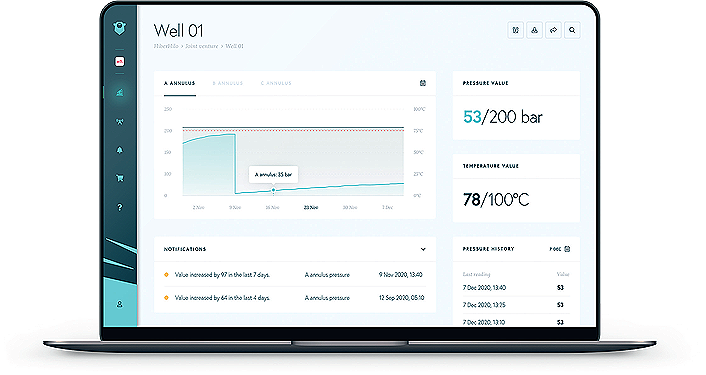
The need to change
THE IMPORTANCE OF DIGITIZING REMOTE OPERATIONS IN THE OIL AND GAS INDUSTRY. BY COEN JANSSEN
The oil and gas industry has traditionally been, and is mostly still, heavily reliant on manual processes. The industry operates mainly in remote and offshore locations – from the Black Sea, a hotspot for drilling hydrocarbons, to gas pipelines running under the Baltic Sea from Russia to Germany. However, this means that it is costly in both budget and resources to maintain and monitor these operations manually. From the maintenance of systems to regular on-site checks of oil and well integrity the industry is reliant on engineers being present and flexible. However, technology is changing this.
In 2017, the World Economic Forum reported ‘that digital transformation in the oil and gas industry could unlock around $1.6 trillion of value for the industry, its customers and wider society.’ However, barriers such as a lack of standardization as well as a lack of technological understanding has stalled buy-in from businesses to implement a holistic digital strategy.
Change is on the horizon though – EY’s 2020 oil and gas digital survey showed that 90 per cent of industry executives agreed that investment in digital technology and the workforce is needed for the industry to survive. This was only compounded this year when the emergence and spread of Covid-19 caused mass disruption across every industry. Specifically, in oil and gas, it forced a huge shift in operations, impacting and limiting the maintenance and checks of oil and well integrity systems. EY’s oil and gas digital transformation and workforce survey revealed 58 per cent of oil and gas executives said the pandemic had increased the urgency of the need to invest in digital technology, with 80 per cent actually planning to invest in the technology to keep up to date with trends.
With travel bans in place, technology provides an opportunity for businesses to adapt and operate from afar – critical for their continued survival during global pandemic. However, this adoption of technology has other benefits, namely making the oil and gas industry more sustainable. And with Covid-19 bringing carbon emissions to the forefront of global conversations, there’s now a much greater call for businesses to make a more eco-friendly move.
Business integration
Field visits to offshore locations are currently complex, time-consuming and expensive, costing up to $40,000 per field visit. The cost of transport, accommodation, personnel and equipment all add up fast. Additionally, manual monitoring is prone to error and is often not conducted frequently enough. Reducing the need to conduct field visits creates a more sustainable business model, but the consistent data monitoring also enables anomalies and issues to be identified early, ensuring issues, such as leaks, are fixed quickly before they create environmental disasters. There are already organizations who are leading a sustainable approach, such as Ocean Infinity who are deploying a new robotic maintenance fleet.
Internet of Things technology can solve these issues through remote monitoring operations. IoT technology is nothing new – many people associate it with smart home devices such as Amazon’s Alexa or Google Home, but its potential is far reaching. At its basic level IoT connects any device to the internet or to each other, enabling them to data share or ‘speak’ to each other. This has the potential to unlock connectivity throughout the oil and gas industry using IoT enabled sensors. A remote, online-based system that can track and communicate to remote locations means operators can monitor and conduct health checks from anywhere – at home or in the office for example. Not only does this cut down the expense of field travel but it provides a more frequent overview of operations, making the data more reliable.
The pandemic forced the industry to reflect on the efficiencies of operations and as a result big organizations are already making changes, with Reuters reporting ‘ghost rigs’ could become the new normal if a solution for maintaining safety and upkeep of the rigs is implemented.
Creating a sustainable future proof industry
No industry is without its faults, but the environmental cost when monitoring is lacking is extremely damaging and we’ve seen this many times, with the recent Mauritius oil spill and the unfortunately infamous Piper Alpha explosion. It’s been reported that the industry’s impact on the climate has been much worse than what has previously been thought, being possibly underestimated by 40 per cent. With the climate crisis at the top of everyone’s agenda, the wellbeing and overview of the rigs and wells that remote monitoring provides puts organizations in better stead to stop faults before they become an issue.
If not for the pandemic the digital transformation of the industry would have been much slower; in the future flexibility should be easier and quicker to realize. A positive consequence is that it has highlighted that the oil and gas industry needs to change. With digital innovation creating new solutions for remote monitoring that enable operators to work remotely. While the industry has come further and is adapting to new technologies that will take them away from old processes, there is still further to go to ensure they are implemented globally.
HIBER
Coen Janssen is co-founder and Chief Strategy Officer, at Hiber. Hiber is an Internet of Things (IoT) solution startup, founded and led by a dream team of satellite experts and tech entrepreneurs. These ‘Hibernauts’ are working on a moonshoot goal: to launch and provide end-to-end IoT solutions connected by satellites in space. More than 55 employees work on the ground-breaking technology behind Hiber and Hiberband at its offices in the Netherlands and USA.
For further information please visit: https://hiber.global